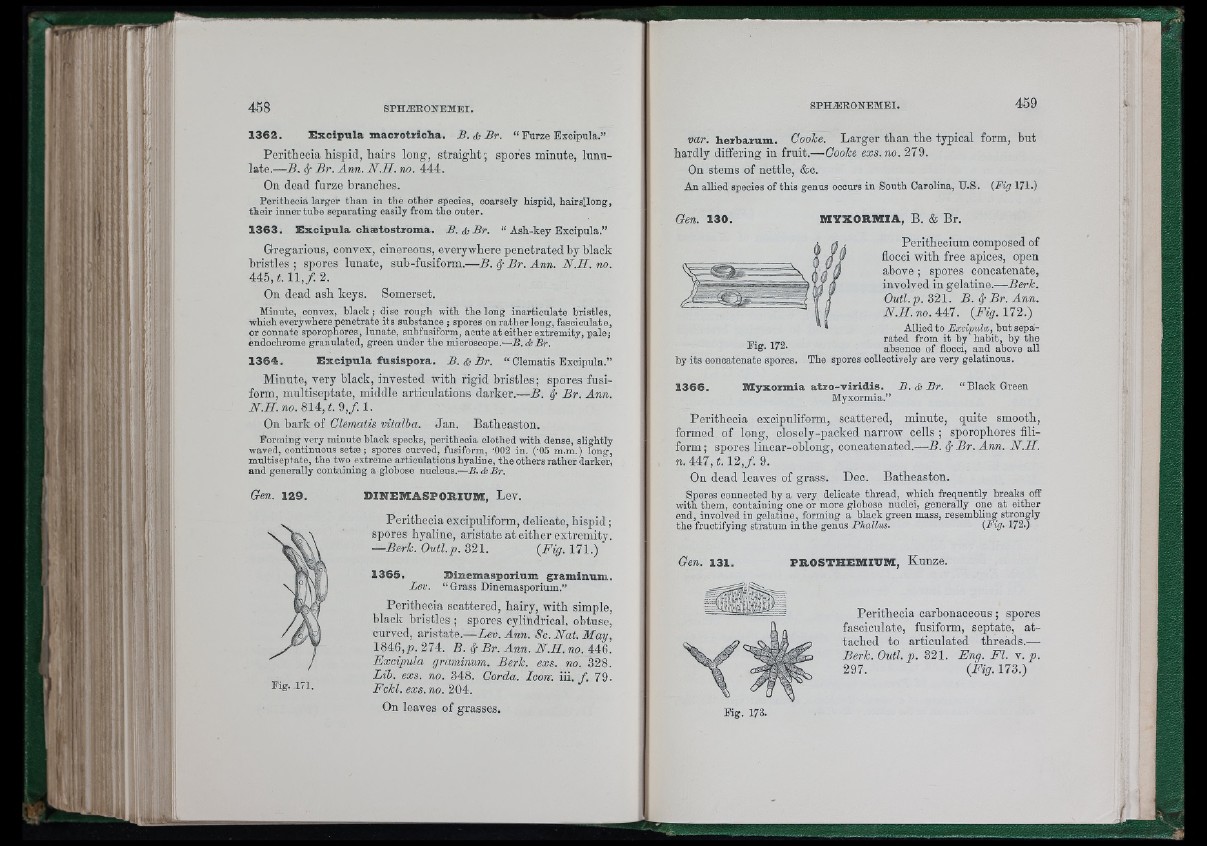
1 3 6 2 . E x c ip u la m a c zo tr ich a . BB .. AA BBrr.. “ Furze Excipula.”
Perithecia hispid, hairs long, straight; spores minute, lumi-
late.—B. 4 Br. Ann. N .H . no. 444.
On dead furze branches.
Perithecia larger than iu the other species, coarsely hispid, hairsllong,
their inner tube separating easily from the cuter.
1 3 6 3 . E x c ip u la chaetostroma. B .A B r . “ Ash-key Excipula.”
Gregarious, convex, cinereous, everywhere penetrated by black
bristles ; spores lunate, sub-fusiform.—B . / Br. Ann. N.H . no.
445, ¿ .1 1 ,/. 2.
On dead ash keys. Somerset.
Minute, convex, black ; disc rough with the long inarticulate bristles,
which everywhere penetrate its substance ; spores on rather long, fasciculate,
or connate sporophores, lunate, subfusiform, acute at either extremity, pale;
endochrome granulated, green under the microscope.—B. & Br.
1 3 6 4 . E x c ip u la fu s isp o r a . B .A B r . “ Clematis Excipula.”
Minute, very black, invested with rigid bristles; spores fusiform,
multiseptate, middle articulations darker.—B. / Br. Ann.
N .H .n o .814, t.9 , f . l .
On bark of Clematis vitalba. Jan. Batheaston.
Forming very minute black specks, perithecia clothed with dense, slightly
waved, continuous setæ; spores curved, fusiform, '002 in, (’05 m.m.) long,
multiseptate, the two extreme articulations hyaline, the others rather darker,
and generally containing a globose nucleus.—B .A Br.
Gen. 1 2 9 . D IN EM A SFO B IUM , Lev.
Peritbeoia excipuliform, delicate, hispid ;
spores hj'aline, aristate a t eitber extremity.
— Berh. Outl.p. 321. {Fig. 171.)
1 3 6 5 . D in em a sp o r ium g zam in um .
Lev. “ Grass Dinemasporium.”
Perithecia scattered, hairy, with simple,
black bristles ; spores cylindrical, obtuse,
curved, aristate.—Ley. Ann. Sc. Nat. M ay,
1846,p. 274. B. 4 B r. Ann. N .H . no. 446.
Excipula graminum. Berh. exs. no. 328.
Lih. exs. no. 348. Corda. Icon, iii. / 79.
Fig. 171. UcyfcZ. exs.no. 204.
On leaves of grasses.
var. h e ib a rum . Coohe. Larger than tbe typical form, but
hardly differing in fruit.— Coohe exs.no. 279.
On stems of nettle, &c.
An allied species of this genus occurs in South Carolina, U.S. (Fig 171.)
Gen. 1 3 0 . IV IÏX O R ia iA , B. & Br.
Fig. 172.
Perithecium composed of
flocci witb free apices, open
above ; spores concatenate,
involved in gelatine.—Berh.
Outl.p. 321. B. 4 B r. Ann.
N .H . no. 441. {Fig. 112.)
Allied to Bxcipula, but separated
from it by habit, by the
absence of ñocoi, and above all
by its concatenate spores. The spores collectively are very gelatinous.
1 3 6 6 . M y x o rm ia a t î o - v i r id i s . B .A B r . “ Black Green
Myxormia.”
Perithecia excipuliform, scattered, minute, quite smooth,
formed of long, closely-packed narrow cells ; sporophores filiform
; spores linear-oblong, concatenated.—B. 4 Br. Ann. N .H .
n. 4 4 7 ,1.1 2 ,/. 9.
On dead leaves of grass. Dec. Batheaston.
Spores connected by a very delicate thread, which frequently breaks off
with them, containing one or more globose nuclei, generally one at either
end, involved in gelatine, forming a black green mass, resembling strongly
the fructifying stratum in the genus Phallus. (Fig. 172.)
Gen. 131. PRO STH EM IUM , Kunze.
Pig. 173.
Perithecia carbonaceous; spores
fasciculate, fusiform, septate, attached
to articulated threads.—
Berh.Outl.p. 321. Eng. F l. Y.p.
297. {Fig. 173.)